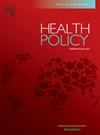Classifying the WHO European countries by noncommunicable diseases and risk factors
IF 3.6
3区 医学
Q1 HEALTH CARE SCIENCES & SERVICES
引用次数: 0
Abstract
Background
In the twenty-first century, noncommunicable diseases (NCDs) are a major obstacle to global development and the accomplishment of the Sustainable Development Goals set forth by the United Nations. The WHO (World Health Organization) European Region lacks comprehensive understanding of NCD risk factors, the NCDs they trigger, and the more disadvantaged countries.
Objective
This study aims to classify the countries in the European Region at the country level based on NCDs and their key risk factors.
Methods
The Ward method, a hierarchical clustering technique based on Manhattan and Euclidean distance measures, was used. The study's dataset comes from the WHO's publicly available NCDs and key risk factors dataset.
Results
The European region's countries have been categorized into two clusters based on key NCD risk factors. The second cluster consists of countries with high income levels. On the other hand, in the European Region, countries fall into three clusters based on NCDs. Countries in the third cluster, which consists of low- and upper-middle-income countries, have lower average values in four variables compared to other countries, resulting in lower overall disease prevalence.
Counclusions
The prevalence of NCDs varies among clusters, with high-income countries having lower disease prevalence, particularly in diabetes and hypertension. Addressing risk factors and improving healthcare access and infrastructure are crucial in reducing the burden of NCDs in the European region.
按非传染性疾病和危险因素对世卫组织欧洲国家进行分类。
背景:在21世纪,非传染性疾病是全球发展和实现联合国制定的可持续发展目标的主要障碍。世卫组织(世界卫生组织)欧洲区域对非传染性疾病风险因素、它们引发的非传染性疾病以及处境较不利的国家缺乏全面了解。目的:本研究旨在根据非传染性疾病及其主要危险因素对欧洲区域的国家进行国家一级的分类。方法:采用Ward方法,一种基于曼哈顿和欧几里得距离测度的分层聚类技术。该研究的数据集来自世卫组织可公开获得的非传染性疾病和关键风险因素数据集。结果:根据主要非传染性疾病风险因素,将欧洲区域的国家分为两类。第二类是高收入国家。另一方面,在欧洲区域,各国根据非传染性疾病分为三组。第三类国家由低收入和中高收入国家组成,与其他国家相比,它们在四个变量中的平均值较低,从而导致总体患病率较低。结论:非传染性疾病的患病率在不同的集群中有所不同,高收入国家的患病率较低,尤其是糖尿病和高血压。在欧洲区域,处理风险因素和改善保健服务和基础设施对于减轻非传染性疾病的负担至关重要。
本文章由计算机程序翻译,如有差异,请以英文原文为准。
求助全文
约1分钟内获得全文
求助全文
来源期刊

Health Policy
医学-卫生保健
CiteScore
6.40
自引率
6.10%
发文量
157
审稿时长
3-8 weeks
期刊介绍:
Health Policy is intended to be a vehicle for the exploration and discussion of health policy and health system issues and is aimed in particular at enhancing communication between health policy and system researchers, legislators, decision-makers and professionals concerned with developing, implementing, and analysing health policy, health systems and health care reforms, primarily in high-income countries outside the U.S.A.
 求助内容:
求助内容: 应助结果提醒方式:
应助结果提醒方式:


